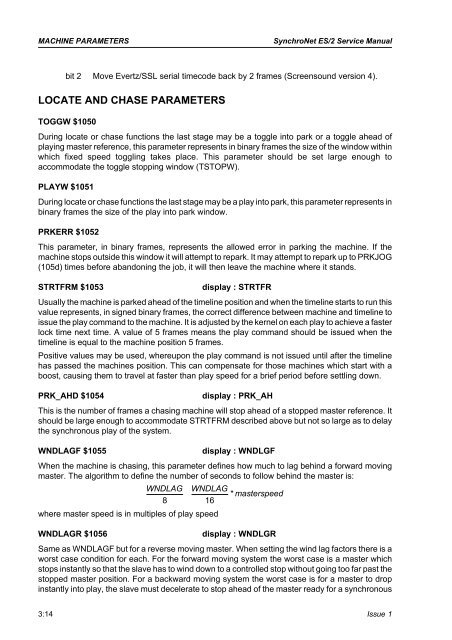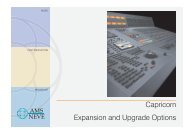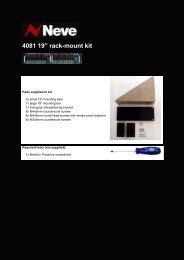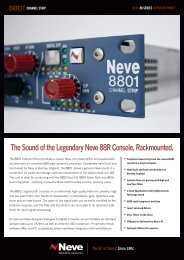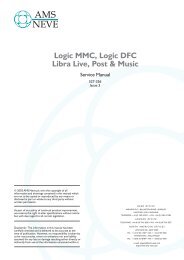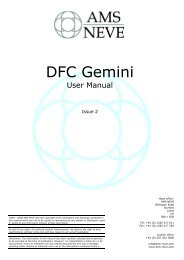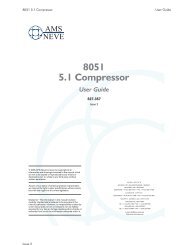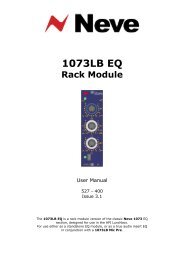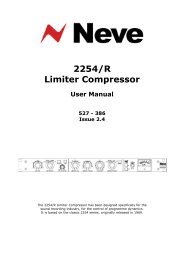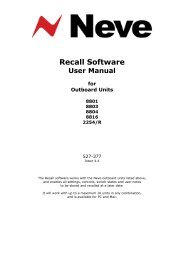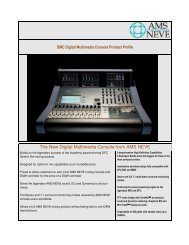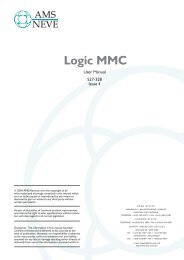Service Manual - AMS Neve
Service Manual - AMS Neve
Service Manual - AMS Neve
You also want an ePaper? Increase the reach of your titles
YUMPU automatically turns print PDFs into web optimized ePapers that Google loves.
MACHINE PARAMETERS<br />
SynchroNet ES/2 <strong>Service</strong> <strong>Manual</strong><br />
bit 2 Move Evertz/SSL serial timecode back by 2 frames (Screensound version 4).<br />
LOCATE AND CHASE PARAMETERS<br />
TOGGW $1050<br />
During locate or chase functions the last stage may be a toggle into park or a toggle ahead of<br />
playing master reference, this parameter represents in binary frames the size of the window within<br />
which fixed speed toggling takes place. This parameter should be set large enough to<br />
accommodate the toggle stopping window (TSTOPW).<br />
PLAYW $1051<br />
During locate or chase functions the last stage may be a play into park, this parameter represents in<br />
binary frames the size of the play into park window.<br />
PRKERR $1052<br />
This parameter, in binary frames, represents the allowed error in parking the machine. If the<br />
machine stops outside this window it will attempt to repark. It may attempt to repark up to PRKJOG<br />
(105d) times before abandoning the job, it will then leave the machine where it stands.<br />
STRTFRM $1053<br />
display : STRTFR<br />
Usually the machine is parked ahead of the timeline position and when the timeline starts to run this<br />
value represents, in signed binary frames, the correct difference between machine and timeline to<br />
issue the play command to the machine. It is adjusted by the kernel on each play to achieve a faster<br />
lock time next time. A value of 5 frames means the play command should be issued when the<br />
timeline is equal to the machine position 5 frames.<br />
Positive values may be used, whereupon the play command is not issued until after the timeline<br />
has passed the machines position. This can compensate for those machines which start with a<br />
boost, causing them to travel at faster than play speed for a brief period before settling down.<br />
PRK_AHD $1054<br />
display : PRK_AH<br />
This is the number of frames a chasing machine will stop ahead of a stopped master reference. It<br />
should be large enough to accommodate STRTFRM described above but not so large as to delay<br />
the synchronous play of the system.<br />
WNDLAGF $1055<br />
display : WNDLGF<br />
When the machine is chasing, this parameter defines how much to lag behind a forward moving<br />
master. The algorithm to define the number of seconds to follow behind the master is:<br />
WNDLAG WNDLAG<br />
* masterspeed<br />
8 16<br />
where master speed is in multiples of play speed<br />
WNDLAGR $1056<br />
display : WNDLGR<br />
Same as WNDLAGF but for a reverse moving master. When setting the wind lag factors there is a<br />
worst case condition for each. For the forward moving system the worst case is a master which<br />
stops instantly so that the slave has to wind down to a controlled stop without going too far past the<br />
stopped master position. For a backward moving system the worst case is for a master to drop<br />
instantly into play, the slave must decelerate to stop ahead of the master ready for a synchronous<br />
3:14 Issue 1


